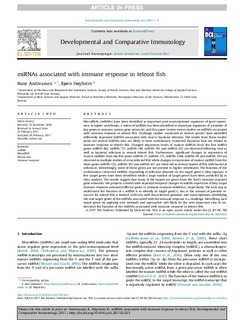| dc.contributor.author | Andreassen, Rune | |
| dc.contributor.author | Høyheim, Bjørn | |
| dc.date.accessioned | 2017-12-08T13:01:35Z | |
| dc.date.available | 2017-12-08T13:01:35Z | |
| dc.date.created | 2017-03-01T14:04:22Z | |
| dc.date.issued | 2017 | |
| dc.identifier.citation | Developmental and Comparative Immunology. 2017, 75 77-85. | nb_NO |
| dc.identifier.issn | 0145-305X | |
| dc.identifier.uri | http://hdl.handle.net/11250/2469808 | |
| dc.description.abstract | MicroRNAs (miRNAs) have been identified as important post transcriptional regulators of gene expression. In higher vertebrates, a subset of miRNAs has been identified as important regulators of a number of key genes in immune system gene networks, and this paper review recent studies on miRNAs associated with immune response in teleost fish. Challenge studies conducted in several species have identified differently expressed miRNAs associated with viral or bacterial infection. The results from these studies point out several miRNAs that are likely to have evolutionary conserved functions that are related to immune response in teleost fish. Changed expression levels of mature miRNAs from the five miRNA genes miRNA-462, miRNA-731, miRNA-146, miRNA-181 and miRNA-223 are observed following viral as well as bacterial infection in several teleost fish. Furthermore, significant changes in expression of mature miRNAs from the five genes miRNA-21, miRNA-155, miRNA-1388, miRNA-99 and miRNA-100 are observed in multiple studies of virus infected fish while changes in expression of mature miRNA from the three genes miRNA-122, miRNA-192 and miRNA- 451 are observed in several studies of fish with bacterial infections. Interestingly, some of these genes are not present in higher vertebrates. The function of the evolutionary conserved miRNAs responding to infection depends on the target gene(s) they regulate. A few target genes have been identified while a large number of target genes have been predicted by in silico analysis. The results suggest that many of the targets are genes from the host’s immune response gene networks. We propose a model with expected temporal changes in miRNA expression if they target immune response activators/effector genes or immune response inhibitors, respectively. The best way to understand the function of a miRNA is to identify its target gene(s), but as the amount of genome resources for teleost fish is limited, with less well characterized genomes and transcriptomes, identifying the true target genes of the miRNAs associated with the immune response is a challenge. Identifying such target genes by applying new methods and approaches will likely be the next important step to understand the function of the miRNAs associated with immune response in teleost fish. | nb_NO |
| dc.language.iso | eng | nb_NO |
| dc.rights | Attribution-NonCommercial-NoDerivatives 4.0 Internasjonal | * |
| dc.rights.uri | http://creativecommons.org/licenses/by-nc-nd/4.0/deed.no | * |
| dc.title | miRNAs associated with immune response in teleost fish | nb_NO |
| dc.type | Journal article | nb_NO |
| dc.type | Peer reviewed | nb_NO |
| dc.description.version | publishedVersion | nb_NO |
| dc.source.pagenumber | 77-85 | nb_NO |
| dc.source.volume | 75 | nb_NO |
| dc.source.journal | Developmental and Comparative Immunology | nb_NO |
| dc.identifier.doi | 10.1016/j.dci.2017.02.023 | |
| dc.identifier.cristin | 1455030 | |
| dc.relation.project | Norges forskningsråd: 254849 | nb_NO |
| cristin.unitcode | 192,16,1,0 | |
| cristin.unitname | Institutt for basalfag og akvamedisin | |
| cristin.ispublished | true | |
| cristin.fulltext | original | |
| cristin.qualitycode | 2 | |

